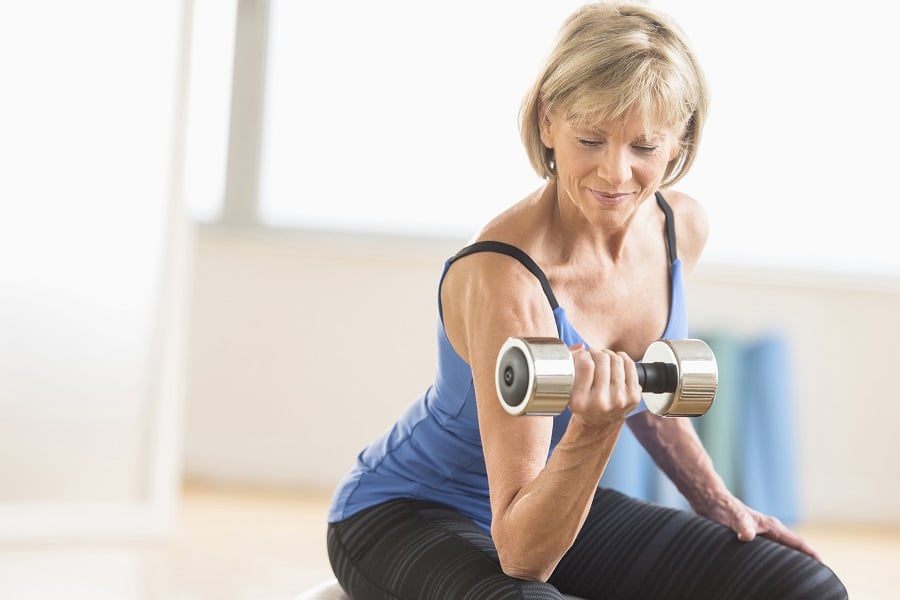
Fight Back Against Age-Related Muscle Loss
If you’re over thirty, it takes hard work to keep looking and feeling young. That’s because Mother Nature plays some dirty tricks on you as you leave your twenties behind—and one of them, which I want to talk about today, is about age-related muscle loss known as aging sarcopenia.
Aging sarcopenia refers to muscle loss that starts to occur in your 30s or early 40s. If you don’t take action, you can lose three to five percent of your muscle tissue each decade.
Translation: weaker muscles, saggy skin, and eventually frailty and an increased risk for dangerous falls. Sarcopenia also packs extra pounds on you, because muscle burns fat—so the less muscle you have, the more fat you store. How can you fight age-related muscle loss?
With the right exercise and the right diet.
Here’s a look at what you need to do—starting now.
Step 1: Do resistance training and HIIT training.
All exercise is good. But to fight sarcopenia, you need the right kind of exercise—and the best type is resistance training, also called strength training. (This means lifting weights, using exercise bands, or doing exercises like planks and pushups that use your body weight as resistance.)
Resistance training strengthens your muscles and optimizes the hormones you need to maintain lean muscle mass. For the maximum muscle-building benefits, I recommend doing resistance workouts at least twice a week (and preferably three times). Make sure you do a good overall workout that includes arm, leg, and core exercises.
Allow one day in between each workout to give your muscles time to recover. Also, if you’re new to resistance exercises, take it slowly at first. Start with light weights and do only as many repetitions as you can complete with good form. When your exercises start getting easy, switch to heavier weights and increase your reps.
By the way, one complaint I sometimes hear is that resistance training makes people too sore. If this is a problem for you, here are some tips for minimizing those aches and pains:
- Indulge in an Epsom salt bath at nighttime if you did an intense workout during the day. The magnesium in the Epsom salt will relax your muscles.
- Eat plenty of protein (more on this below).
- Stay hydrated. Your muscles need plenty of water to recover after a workout.
- Try beetroot. One study found that drinking beetroot juice after a workout significantly reduced post-exercise pain.
- Drink coffee before your workouts. As I mentioned in an earlier post, a pre-workout cup of coffee will enhance your performance and reduce post-exercise pain.
- Don’t waste time doing “static stretches” like toe touches before or after a workout, because research shows that these won’t lower your risk of muscle pain the next day. Instead, do some dynamic stretches that activate the muscles you’ll be using in your routine—for instance, easy squats and kicks.
- Roll away post-workout aches and pains with a tennis ball or a foam roller.
Along with doing resistance workouts, consider adding high-intensity interval training (HIIT) to your regimen. New research indicates that HIIT also is a powerful weapon against sarcopenia.
Step 2: Eat right.
In addition to building lean muscle mass through resistance training and HIIT training, you can fight sarcopenia by giving your muscles the nutrients they need. Here are the biggest keys:
- Get plenty of protein in your diet from grass-fed meat, free-range chicken and eggs, and wild-caught fish. This is especially important after you work out. When you exercise, you actually create tiny tears in your muscles—and it’s the repair of those tears that makes your muscles stronger. Your body needs the amino acids from proteins to make those repairs and to ease exercise-linked aches and pains.
- Load up on anti-inflammatory foods such as leafy greens and berries. There’s a strong link between inflammation and sarcopenia.
- Get plenty of Vitamin D and omega-3 fatty acids in your diet. Research shows that a deficiency of vitamin D, or a deficiency of omega-3s in comparison to omega-6s, can up your risk for sarcopenia. So get some sunlight every day, take a vitamin D supplement, and eat plenty of fatty fish (or take an omega-3 supplement).
Step 3 Mini-Fast
Exercising in a fasted state can help you build and tone your muscles while burning more fat than in a non-fasted state. Studies show mini-fasting and interval training workouts increase Hormone Growth Hormone (HGH) by 1300% in women! This is important because HGH is essential to sculpting lean muscle. And the more muscle you have, the more fat you’ll burn.
Bottom Line: Mini-fasting is great for your waistline. But exercising while fasting will speed up your fat loss as well as boost your body's muscle building power.
— No matter how old you are, it’s never too early—or too late—to prevent or even reverse muscle loss due to aging. Remember: You can choose to age… or you can refuse to age. If you need inspiration, watch this video of 91-year-old Sy Perlis lifting 187 pounds to break a world record in his age group—or this video I’ve shared before of 80-year-old Ernestine Shepherd, who started weight training at 71 and has a body most twenty-year-olds would envy. If they can say NO to sarcopenia, so can you!
Keep thinking Big and living BOLD!








